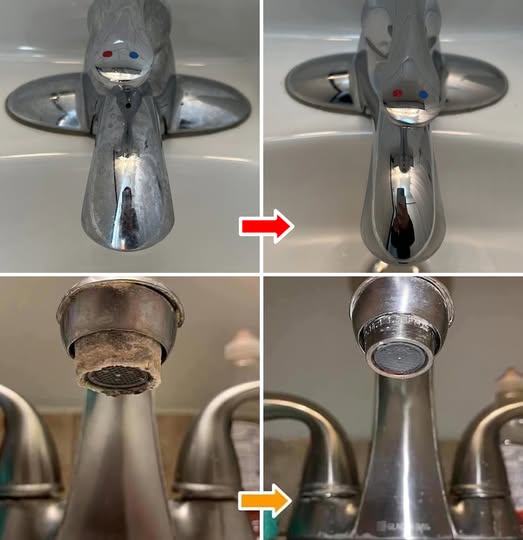ADVERTISEMENT
2. Daily Cleaning Routine
For regular maintenance and to keep your faucet looking fresh, you can follow this quick and easy cleaning method:
- Wipe with Soap and Water: Start by wiping down your faucet with warm water and a few drops of dish soap. This helps to remove any dust, grime, and light soap scum that may have accumulated on the surface.
- Dry with a Microfiber Cloth: After wiping down the faucet, use a microfiber cloth to dry it off and buff away any water spots. This prevents water marks and keeps the faucet shiny.
3. Tackling Water Spots and Mineral Deposits
If you notice stubborn water spots or mineral deposits, it’s time to use a more targeted method. Hard water is often the culprit, and you can use vinegar or lemon juice to tackle this issue.
- Soak a Cloth in Vinegar or Lemon Juice: Soak a soft cloth or paper towel in white vinegar or lemon juice. Apply the soaked cloth to the areas with water spots or mineral build-up and let it sit for 15-30 minutes. The acid in the vinegar or lemon juice will break down the mineral deposits.
- Scrub the Faucet: After soaking, use a non-abrasive sponge or an old toothbrush to gently scrub the faucet. Focus on areas with heavy build-up. You’ll notice that the mineral deposits come off easily after the soaking time.
- Rinse and Dry: Once you’ve scrubbed the faucet, rinse it with warm water to remove any remaining vinegar or lemon juice. Dry with a microfiber cloth to restore its shine and prevent any new spots from forming.
4. Removing Tough Stains
For stains or discoloration, baking soda is your best friend. It’s gentle enough not to scratch the faucet’s surface but powerful enough to tackle tougher stains.
- Make a Baking Soda Paste: Mix a tablespoon of baking soda with a few drops of water to create a paste. Apply the paste directly to the stained areas of the faucet.
- Scrub Gently: Use a soft-bristle brush or sponge to scrub the paste into the stains. Focus on the affected areas and use gentle circular motions to avoid scratching.
- Rinse and Buff: Rinse the faucet with warm water to remove the paste. Dry it with a clean microfiber cloth to reveal a clean, fresh surface.
5. Shining Up the Faucet
Once you’ve tackled stains and build-up, it’s time to give your faucet a good shine.
- Polish with Olive Oil or Baby Oil: For a shiny, streak-free finish, apply a small amount of olive oil or baby oil to a clean cloth. Gently buff the surface of the faucet, focusing on the faucet body and handles. The oil will add a beautiful shine while also helping to repel water spots.
- Polish with a Dry Cloth: Finally, use a dry microfiber cloth to buff the faucet further. This will remove any excess oil and ensure a polished, sparkling finish.
6. Dealing with Rust or Corrosion
Rust and corrosion can sometimes appear on faucets, especially older ones or those exposed to moisture for long periods.
- Apply Baking Soda and Vinegar: Make a paste using baking soda and vinegar, then apply it directly to the rusted areas. Let it sit for about 15-20 minutes, as the combination of vinegar’s acidity and the abrasiveness of baking soda will help break down the rust.
- Scrub with a Soft Brush: Use a soft-bristle brush or toothbrush to gently scrub the rust. Be sure to avoid using any abrasive pads or scrubbers, as they could scratch the faucet’s surface.
- Rinse and Dry: After cleaning the rust, rinse the faucet thoroughly with warm water and dry it with a clean towel.
Tips for Maintaining Clean Faucets
- Avoid Harsh Chemicals: Harsh chemicals and abrasive cleaners can damage the finish of your faucet over time. Stick to gentle, natural cleaners like vinegar, lemon juice, and baking soda.
- Regular Cleaning: To prevent build-up, make faucet cleaning part of your regular routine. Wipe down the faucet daily with a soft cloth to remove water spots and soap scum.
- Consider a Water Softener: If you live in an area with hard water, consider installing a water softener to reduce mineral deposits and protect your faucets from water spots and build-up.
Final Thoughts
With these simple cleaning tips and tricks, your faucets can look brand new again. Whether you’re dealing with water spots, mineral deposits, or rust, you now have the knowledge to restore your faucets to their original shine. A little regular maintenance goes a long way in keeping your bathroom or kitchen sparkling clean!
By using natural, non-abrasive cleaning methods, you’ll not only keep your faucets looking beautiful but also prolong their lifespan. So, roll up your sleeves, gather your supplies, and enjoy a clean, gleaming faucet in no time!
ADVERTISEMENT
